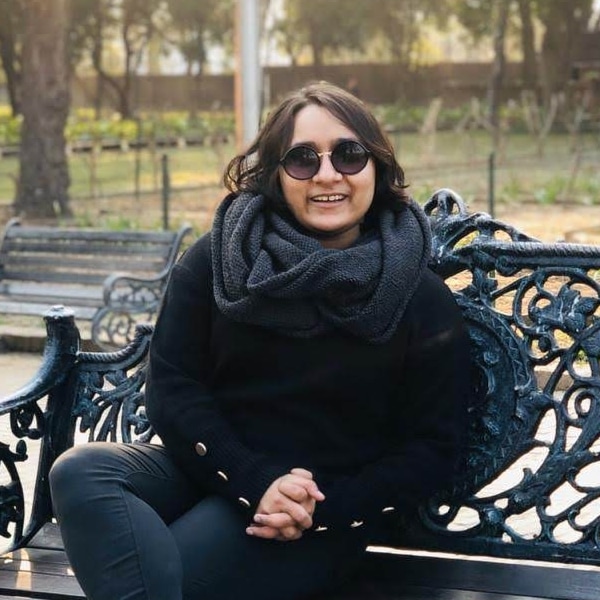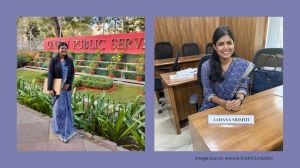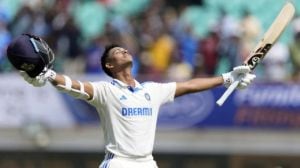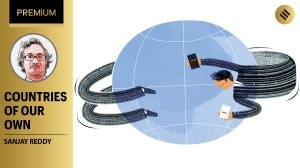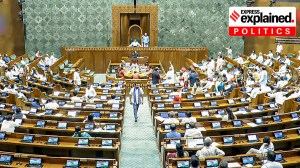UPSC Key: Myanmar Earthquake, Right to Equality, and AI literacy
Why the norms surrounding disclosure of judges’ assets is relevant to the UPSC exam? What is the significance of topics such as the earthquake, biotechnology in agriculture, and AI literacy have on both the preliminary and main exams? You can learn more by reading the Indian Express UPSC Key for March 29, 2025.
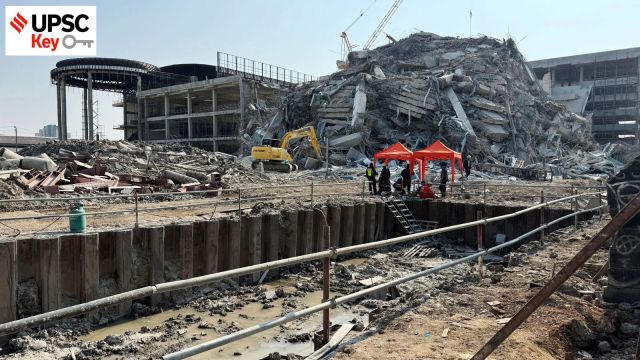 UPSC Key: Rescuers walk at the site of a high-rise building under construction that collapsed after a 7.7 magnitude earthquake in Bangkok, Thailand, Friday, March 28, 2025. (AP Photo/Sakchai Lalit)
UPSC Key: Rescuers walk at the site of a high-rise building under construction that collapsed after a 7.7 magnitude earthquake in Bangkok, Thailand, Friday, March 28, 2025. (AP Photo/Sakchai Lalit)Important topics and their relevance in UPSC CSE exam for March 29, 2025. If you missed the March 28, 2025, UPSC CSE exam key from the Indian Express, read it here.
FRONT
Quake toll jumps to nearly 700, 1,670 injured, says reports as rescue ops continue
Syllabus:
Preliminary Examination: Indian and World Geography – Physical, Social, Economic geography of India and the
World
Mains Examination: General Studies-I: Important Geophysical phenomena such as earthquakes, Tsunami, Volcanic activity, cyclones. etc., geographical features and their location-changes in critical geographical features (including water-bodies and ice-caps) and in flora and fauna and the effects of such changes.
What’s the ongoing story: At least 694 people in Myanmar have been killed and 1,670 injured after a 7.7-magnitude earthquake struck on Friday, state-run MRTV said on the Telegram messaging app, Reuters reported. Tremors were felt across the region, including in Bangkok, where a high-rise under construction collapsed, killing at least eight and leaving over 117 missing. The Thai capital has been declared a disaster area.
Key Points to Ponder:
• What is an earthquake?
• What are p-waves and s-waves?
• What are tectonic plates?
• What are the major tectonic plates?
• What is the “strike slip faulting”?
• The location below the earth’s surface where the earthquake starts is called?
• What is the theory of plate tectonics?
• What are the different earthquake zones in India?
Key Takeaways:
• Earth’s lithosphere, the rigid outermost rocky shell of the planet, is made up of a number of tectonic plates. These have been slowly moving over the last three-four billion years, with their interaction responsible for many of the planet’s geological features.
• Earthquakes occur when two tectonic plates suddenly slip past one another. This releases stored-up “elastic strain” energy in the form of seismic waves, and causes the ground to shake.
• The USGS said the Myanmar earthquake took place due to the “strike slip faulting” between the Indian and Eurasian plates, meaning these two plates rubbed sideways against each other.
• The quake took place on the Sagaing Fault, which runs north to south through the centre of Myanmar, and is prone to earthquakes. A fault is a fracture or zone of fractures between two blocks of rock, which allows the blocks to move relative to each other, sometimes leading to earthquakes.
• Myanmar frequently experiences earthquakes due to the Sagaing fault. Since 1900, at least six quakes of magnitude greater than 7 have occurred near the Sagaing Fault, according to USGS data.
• Over the last 100 years, Myanmar has witnessed 14 earthquakes of magnitude 6 or above. But one of the worst earthquakes to occur in the region came in 1839.
Do You Know:
• An earthquake is an intense shaking of the ground caused by movement under the earth’s surface. It happens when two blocks of the earth suddenly slip past one another. This releases stored-up ‘elastic strain’ energy in the form of seismic waves, which spread through the earth and cause the shaking of the ground.
• The earth’s outermost surface, crust, is fragmented into tectonic plates. The edges of the plates are called plate boundaries, which are made up of faults. The tectonic plates constantly move at a slow pace, sliding past one another and bumping into each other. As the edges of the plates are quite rough, they get stuck with one another while the rest of the plate keeps moving. Earthquake occurs when the plate has moved far enough and the edges unstick on one of the faults.
• USGS says that “the location below the earth’s surface where the earthquake starts is called the hypocenter, and the location directly above it on the surface of the earth is called the epicentre.”
• Shallow quakes are generally more dangerous as they carry more energy when they emerge to the surface when compared to quakes that occur deeper underneath the surface. While deeper quakes do indeed spread farther as seismic waves move radially upwards to the surface, they lose energy while travelling greater distances.
• Apart from the depth, the magnitude of an earthquake is also an indicator of how destructive a quake could be. Magnitude tells how big the seismic waves are, while strength refers to the energy they carry.
• The surface of the Earth is divided into 7 major plates and several minor ones. They move a few centimetres a year, riding on semi-molten layers of rock underneath the crust. As the plates move, they pull apart or collide, unleashing the powerful movements known as earthquakes.
Other Important Articles Covering the same topic:
📍Knowledge nugget of the day: Earthquakes—Why is the Himalayan zone seismically active?
📍Why Myanmar is frequently rocked by earthquakes
Prelims Question Covering similar theme:
(1) Consider the following statements:
1. Nazca plate is between South America and Pacific plate
2. Juan De Fuca plate is present in Southern Atlantic Ocean
Which of the following statements is/are correct?
(a) 1 only
(b) 2 only
(c) Both 1 and 2
(d) Neither 1 nor 2
Previous year UPSC Mains Question Covering similar theme:
Discuss about the vulnerability of India to earthquake related hazards. Give examples including the salient features of major disasters caused by earthquakes in different parts of India during the last three decades. (2021)
Cabinet clears Rs 23k-cr scheme for electronic components, targets 92k jobs
Syllabus:
Preliminary Examination: Current events of national and international importance
Mains Examination: General Studies-II: Government policies and interventions for development in various sectors and issues arising out of their design and implementation.
What’s the ongoing story: The Union Cabinet on Friday cleared a Rs 22,919 crore incentive scheme for manufacturing electronic components, spread over a period of six years. The scheme aims to deepen India’s presence in global value chains, while increasing domestic value addition in the country.
Key Points to Ponder:
• What is a global value chain?
• What are government initiatives for export-led promotion?
• How is it different from the Production-linked initiative?
• What are the key challenges in terms of electronic components manufacturing?
• What is the objective of introducing this scheme?
• What is the potential of the electronics industry in India?
Key Takeaways:
• The government is hoping that at least 91,600 direct jobs will be created as part of the scheme, and has tied participating entities’ yearly subsidies to the number of jobs they create.
• The components that the government is looking to target through the scheme include display modules, sub assembly camera modules, printed circuit board assemblies, lithium cell enclosures, resistors, capacitors, and ferrites, among others.
• Components import will reduce after this scheme. We need to come out of the import substitution mindset and go forward with export led promotion. Viability comes after large scale manufacturing. Electronics manufacturing is around $120 billion right now and we are targeting that to grow to $500 billion in the coming years,” Union IT Minister Ashwini Vaishnaw said.
• This incentive scheme differs from the government’s earlier production linked incentive (PLI) scheme for electronics manufacturing in how participating companies can avail subsidies. Incentives have been linked to three key parameters: annual employment generation, capital expenditure needs and annual production.
• The components incentive scheme is a crucial next step as the PLI scheme for smartphone manufacturing is nearing its sunset.
• The government has identified three key challenges in terms of electronic components manufacturing. First, the current lack of domestic scale in the country. Second, a high investment to turnover ratio — in terms of finished products such as smartphones. Third, India has high domestic demand, because of which a large chunk of components are being imported.
Do You Know:
• Electronics is among India’s three largest exported commodities, valued at Rs 2.5 lakh crore. That is likely to double in the next four years. Electronics is the second largest import commodity after oil, accounting for nearly 75 per cent of the total electronics production in India.
• In order to boost domestic manufacturing and cut down on import bills, the central government introduced PLI that aims to give companies incentives on incremental sales from products manufactured in domestic units. Apart from inviting foreign companies to set shop in India, the scheme also aims to encourage local companies to set up or expand existing manufacturing units.
• According to experts, the idea of PLI is important as the government cannot continue making investments in these capital intensive sectors as they need longer times for start giving the returns. Instead, what it can do is to invite global companies with adequate capital to set up capacities in India.
Other Important Articles Covering the same topic:
📍Explained: What is PLI scheme, and which sectors will be under it?
📍PLI review 5 years on | On Govt table: PLI 2.0, what next to push manufacturing
UPSC Prelims Question Covering similar theme:
(2) Consider, the following statements : (2023)
Statement-I : India accounts for 3.2% of global export of goods.
Statement-II : Many local companies and some foreign companies operating in India have taken advantage of India’s ‘Production-linked Incentive’ scheme.
Which one of the following is correct in respect of the above statements?
(a) Both Statement-I and Statement-II are correct and Statement-II is the correct explanation for Statement-I
(b) Both Statement-I and Statement-II are correct and Statement-II is not the correct explanation for Statement-I
(c) Statement-I is correct but Statement-II is incorrect
(d) Statement-I is incorrect but Statement-II is correct
EXPRESS NETWORK
When a landlord cited right to equality, went to court against a Rs 2 tax on his forest land
Syllabus:
Preliminary Examination: Indian Polity and Governance-Constitution, Political System, Panchayati Raj, Public Policy, Rights Issues, etc.
Main Examination: General Studies II: Indian Constitution—historical underpinnings, evolution, features, amendments, significant provisions and basic structure.
What’s the ongoing story: Kunnathat Thathunni was a ‘Moopil Nair’, a title held by some of the feudal landlords in Malabar — so rich that besides vast tracts of agricultural land, he owned at least 50,000 acres of forest land filled with “rocks, rivulets and gorges” in present-day Palakkad district of Kerala.
Key Points to Ponder:
• Know about Kunnathat Thathunni Moopil Nair vs The State Of Kerala
• Which constitutional articles give power to the state for taxing an individual?
• Any tax would be arbitrary and unequal if it were not based on a reasonable classification. What does it mean?
• What is the significance of the principle that the state cannot impose a tax without a rational classification?
• In the present context, should agricultural income be taxed?
• What is the Right to Equality? How is it protected by the Constitution?
Key Takeaways:
• So when the state government — the first democratically elected Communist government led by EMS Namboodiripad that came to power in 1957 — imposed a flat tax of Rs 2 on every acre of land owned by private individuals, irrespective of the kind of land, Thathunni was quick to move the Supreme Court.
• Kunnathat Thathunni Moopil Nair vs The State Of Kerala set a guiding rule for the state to tax individuals, one that is relevant even today — that any tax would be arbitrary and unequal if it is not based on a reasonable classification.
Nair’s case was that the land did not give him returns to even match the tax demand. His income from the forest land, he said, was Rs 3,100 a year that he got from the highest bidder who bought the rights to chop trees in about 450 acres of his forest land.
• On December 9, 1960, a five-judge bench of the Supreme Court agreed with Nair and struck down the Kerala government’s flat tax. Then Chief Justice B P Sinha said that the Act “does not lay down any principle or policy for the guidance of the exercise of discretion by the Government”.
• “The spirit of the ruling is the reason why we have different income tax slabs for people with different earning capacities. The government has to classify equals and unequals and treat them differently,” Datar explains.
Do You Know:
• Article 14 of the Indian Constitution states: “The State shall not deny to any person equality before the law or the equal protection of the laws within the territory of India.”
• India’s states have the power to tax mining activities, and collecting “royalties” from mining leaseholders is entirely separate from, and does not interfere with, the power to impose taxes, a nine-judge Constitution Bench ruled in July 2024.
• Royalties refer to the fees paid to the owner of a product in exchange for the right to use that product. For example, if a movie studio wants to use an existing piece of music by a specific artist in their new film, they will have to pay a royalty fee that goes to the artist.
• The majority held that a royalty is not a tax because there is a “conceptual difference” between royalties and taxes. Royalties are based on specific contracts or agreements between the mining leaseholder and the lessor (the person who leases the property) who can even be a private party.
• Also, taxes are meant for public purposes such as welfare schemes and creating public infrastructure, whereas the payment of royalties is to a lessor in exchange “for parting with their exclusive privileges in the minerals”.
Other Important Articles Covering the same topic:
📍‘Royalty is not a tax’: How Supreme Court recognised states’ powers to tax mining activities
Prelims Question Covering similar theme:
(3) Consider the following statements:
1. The power to levy taxes on agricultural income is in the concurrent list of the Seventh schedule.
2. Agriculture is exempt from income tax under Section 2(1A) of the Income Tax Act.
Which of the following statements is/are correct?
(a) 1 only
(b) 2 only
(c) Both 1 and 2
(d) Neither 1 nor 2
EXPLAINED
What are the norms surrounding disclosure of judges’ assets?
Syllabus:
Preliminary Examination: Indian Polity and Governance – Constitution, Political System, Panchayati Raj, Public Policy, Rights Issues
Mains Examination: General Studies-II: Structure, organisation and functioning of the Executive and the Judiciary—Ministries and Departments of the Government; pressure groups and formal/informal associations and their role in the Polity.
General Studies-IV: Probity in Governance: Concept of public service; Philosophical basis of governance and
probity; Information sharing and transparency in government, Right to Information, Codes of Ethics, Codes of Conduct, Citizen’s Charters, Work culture, Quality of service delivery, Utilisation of public funds, challenges of corruption
What’s the ongoing story: The discovery of wads of cash at the residence of Delhi High Court judge Justice Yashwant Varma has raised concerns regarding corruption in India’s higher judiciary. Among other things, it has given impetus to those arguing for the public disclosure of judges’ assets and liabilities. Unlike other public servants, judges are not bound to make this information public, and in the majority of cases, they have not done so.
Key Points to Ponder:
• Is a declaration of judges’ assets and liabilities part of disclosure of “personal information”? What is the Supreme Court ruling in this?
• Does the Right to Information Act apply to the declaration of personal assets by judges?
• How has the RTI Act ensured accountability of the Executive? Why are judges kept outside of this preview?
• What are the challenges in the judicial system of India?
• How are judges appointed? What is the procedure for the impeachment of a judge?
Key Takeaways:
• In a meeting in 1997 chaired by then Chief Justice of India J S Verma, the Supreme Court adopted a resolution which stated: “Every judge should make a declaration of all assets in the form of real estate or investment held in their names, in the name of their spouses or any other person dependent on them, to the Chief Justice.”
• This was not a call for public disclosure of the assets of judges — only a disclosure to the Chief Justice.
• Later, in a meeting held on September 8, 2009, the full Bench of the Supreme Court resolved to declare the assets of judges on the court’s website, but added that this was being done “purely on a voluntary basis”.
• As of March 1 this year, there are 770 judges in all the High Courts put together. Of these, only 97 judges from seven High Courts — Delhi, Punjab & Haryana, Himachal Pradesh, Madras, Chhattisgarh, Kerala, and Karnataka — have publicly declared their assets and liabilities. This amounts to less than 13% of all High Court judges.
• The Indian Express had earlier filed an RTI application requesting information regarding the assets and liabilities of the judges of the Allahabad High Court. The court rejected the request, saying that such information fell outside the ambit of the RTI Act.
• In view of this situation, Parliament’s Committee on Personnel, Public Grievances, and Law and Justice had recommended in 2023 that legislation should be introduced to ensure the mandatory disclosure of assets and liabilities of judges of the Supreme Court and High Courts. But there has been no progress on the recommendation yet.
• Public servants, unlike judges, are often mandated to declare their assets, and this information is often easily accessible to ordinary citizens.
• The passage of the RTI Act in 2005, which seeks to promote transparency and accountability in the working of the government, has played a key role in this regard.
• Beginning with the UPA-2 government (2009-14), it has become a norm for Union Ministers — including the Prime Minister — to submit their declarations to the Prime Minister’s Office. Nowadays, these can be accessed via the PMO’s website. Many state governments have followed suit.
Do You Know:
• The RTI Act, which came into force in October 2005, was seen as a significant development towards freedom of information. It gave ordinary citizens the right to request information from government bodies, making authorities accountable for their actions and decisions.
• The roots of the RTI Act lie in a grassroots movement in rural Rajasthan. In the 1980s, civil society organisations and villagers in Devdungri, a small village in Rajsamand district, led struggles to address issues such as fair wages, accountability from government officials, and access to information about local employment records, including muster rolls, to ensure fair compensation.
• The first draft provisions for RTI were prepared in 1993 by the Consumer Education and Research Council (CERC). It was followed by the Press Council’s draft, which had some of the significant features that would later become central to the RTI Act.
• One of the biggest impediments to the effective implementation of the RTI Act is the Official Secrets Act (OSA) of 1923. Enacted during British rule, the OSA was designed to maintain the confidentiality of official information by making it an offence to share and disseminate any classified information.
Other Important Articles Covering the same topic:
📍Tracing the roots and impact of Right to Information Act
📍Assets of 13% of High Court judges in public domain, 80% of those from just 3 HCs: Official data
UPSC Mains Question Covering similar theme:
The Right to Information Act is not all about citizens’ empowerment alone, it essentially redefines the concept of accountability.” Discuss.(2018)
THE EDITORIAL
Losing the thread
Syllabus:
Preliminary Examination: Current events of national and international importance
Mains Examination: General Studies-III: Indian Economy and issues relating to planning, mobilisation, of resources, growth, development and employment
What’s the ongoing story: Harish Damodaranwrites Consider the following: Between 2002-03 and 2013-14, India’s cotton production almost trebled from 13.6 million to 39.8 million bales (mb; 1 bale=170 kg). Cut to 2024-25, when India’s output is projected at 29.5 mb, the lowest since the 29 mb of 2008-09. Also, imports at 3 mb would surpass exports of 1.7 mb. In short, we are back to being a net importer of the natural fibre.
Key Points to Ponder:
• What is the role of technology in cotton production?
• Know about the role of biotechnology and nanotechnology in agriculture?
• Which GM crop cultivation is allowed in India?
• What are the benefits of GM crop cultivation?
• What is genetically modified (GM) Bt cotton?
• What is the role of the Genetic Engineering Approval Committee?
• What are the concerns raised around Genetically Modified Crops?
• What is pink bollworm? How is it a threat to cotton production?
• How can new-age technology be integrated in the agriculture sector?
• It is high time Indian agriculture transforms into precision agriculture by using modern tools of biotechnology. Elaborate.
• Know about H-4, Varalaxmi, Labh Singh, and Bt “Cry1Ac”
Key Takeaways:
• How did India become a pre-eminent producer and exporter of cotton? The answer is technology. India has had some of the finest cotton breeders. C T Patel developed “H-4”, the world’s first cotton hybrid released for commercial cultivation in 1970 and obtained from crossing two Gossypium hirsutum varieties, Gujarat-67 and American Nectariless.
• B H Katarki bred “Varalaxmi”, the world’s first inter-specific cotton hybrid — a cross between a hirsutum (Lakshmi) and barbadense (SB298 E) species variety of the same Gossypium genus — that was released in 1972.
• Before them was the legendary Labh Singh — his “LSS” (Labh Singh Selection) variety, released in 1933, was grown extensively in Punjab and been used for hybridisation even in Pakistan.
• This tradition of openness to new technologies and breeding innovations also enabled the commercialisation of genetically modified (GM) Bt cotton hybrids in India. The first of these — incorporating a gene isolated from a soil bacterium, Bacillus thuringiensis, producing proteins toxic to the deadly American bollworm pest — was planted from the 2002-03 crop season.
• This was followed four years later by GM hybrids based on a second-generation Bollgard-II technology, deploying two Bt genes to confer protection against the Spodoptera cotton leafworm pest as well.
• The slide began during the second term of the UPA government, which announced a “moratorium” on GM Bt brinjal, overruling the Genetic Engineering Approval Committee’s go-ahead for its planting by farmers.
• A host of other GM crops and even indigenously developed transgenic events have struggled to jump through regulatory hoops, erected ostensibly to safeguard against the “risks” their release may pose to the country’s agricultural ecosystems, biodiversity, and human and animal health.
• With the courts also stepping in to decide on matters best left to those with technical expertise and domain knowledge, the regulatory deadlock has been total…
• The ultimate beneficiary of India turning a net importer would be the world’s top exporters, the US and Brazil. They — the former in particular — are likely to push for the removal of the 11 per cent import duty now on cotton.
• All this while, the Indian farmer has been denied access to technology. Nobody asked him then, nobody will today. Will the activists who blocked the field trials of GM crops block the entry of GM soyameal and corn through Nhava Sheva or Visakhapatnam ports?
Do You Know:
• Biotechnology, the science of manipulating biological organisms and processes to develop desired products or applications, is a vast and diverse field. It includes areas such as genomics, genetic engineering, synthetic biology, bioinformatics, gene therapy, etc.
• Knowledge in these areas has been used to find cures for genetic disorders or develop new varieties of plants that, for example, have special desirable traits. So far, biotechnology-based solutions have been applied largely in the fields of medical science and agriculture.
• However, recent breakthroughs in gene editing technologies, protein synthesis, or the ability to grow specific enzymes using genetically modified microorganisms, coupled with increased data processing capabilities and the use of artificial intelligence, have opened up new possibilities for biotechnology.
• The BioE3 policy of the government, which was launched last year, envisages the setting up of several biomanufacturing hubs across India. At these hubs, industry partners and start-ups can establish facilities for producing specialised chemicals, smart proteins, enzymes, functional foods, and other bio-products and services.
• The hubs will focus on six areas — bio-based chemicals and enzymes, functional foods and smart proteins, precision biotherapeutics, climate resilient agriculture, carbon capture and utilisation, and futuristic marine and space research.
Other Important Articles Covering the same topic:
📍Centre’s new BioE3 policy: How can biotechnology be harnessed for economic development?
Previous year UPSC Prelims Question Covering similar theme:
(4) Bollgard I and Bollgard II technologies are mentioned in the context of (2021)
(a) clonal propagation of crop plants
(b) developing genetically modified crop plants
(c) production of plant growth substances
(d) production of biofertilizers
Previous year UPSC Mains Question Covering similar theme:
How can biotechnology help to improve the living standards of farmers? (2019)
THE IDEAS PAGE
The new reading and writing
Syllabus:
Preliminary Examination: Current events of national and international importance
Mains Examination: General Studies-III: Science and Technology- developments and their applications and effects in everyday life and Achievements of Indians in science & technology; indigenization of technology and
developing new technology.
What’s the ongoing story: Aditya Vishwanath and Ujwal Thakar write just as the industrial era demanded reading and writing, the AI era demands a new kind of fluency: AI literacy.
Key Points to Ponder:
• What is the role of AI in education and health?
• Why is AI literacy important?
• What is the IndiaAI Mission?
• What are India’s efforts in the integration of AI in governance?
• What are the potential benefits and challenges associated with AI?
• True AI literacy is about cultivating a mindset of problem-solving, abstraction, and systems thinking. Why?
Key Takeaways:
• Today, we stand at a similar inflection point with artificial intelligence (AI). Just as past generations prioritised literacy as a fundamental right and a strategic necessity, we must now make the case for AI literacy as an essential skill for the next generation of young Indians.
• Computational thinking (CT) — promoted in the early 2000s by scholars like Jeannette Wing of Columbia University — was envisioned as a foundational skill for every child, comparable to maths or reading.
• Comprehensive AI literacy must now encompass all layers of Indian society — from foundational K-12 education to extensive higher education programmes, targeted workforce training, inclusive micro-courses for diverse non-technical professions, and broad-based, culturally aware initiatives aimed at AI literacy for the masses.
• But what does AI literacy actually mean? Here are three distinct ways to define it. One, AI literacy as “human-AI collaboration”. Understanding how AI systems work and how to effectively collaborate with them as co-pilots, rather than being passive users.
• Two, AI literacy as “critical AI awareness”. The ability to interpret and critique AI-generated content, recognising bias, fairness, and ethical implications in automated decision-making.
• Three, AI literacy as “problem-solving with AI”. The capacity to design, apply, and creatively leverage AI to solve real-world challenges, regardless of whether one is a programmer or not.
• Most importantly, AI literacy is not just about coding. While programming is one way to engage with AI, true AI literacy is about cultivating a mindset of problem-solving, abstraction, and systems thinking — skills that are essential for any profession in an AI-driven world.
• India’s potential is already emerging — from Wadhwani AI’s agricultural solutions to Sarvam AI’s generative AI breakthroughs. Scaling such innovation requires deep investment in AI education, research, and entrepreneurship.
• A national initiative for AI literacy is critical. Policymakers must integrate AI into school curricula, industries must invest in workforce skilling, and civil society must ensure equitable access — so no Indian is left behind in the AI age.
Do You Know:
• Last year, the Union Cabinet approved the IndiaAI Mission with an outlay of Rs 10,372 crore for the next five years, under which the government will allocate funds towards subsidising private companies looking to set up AI computing capacity in the country, among other things.
• Under the IndiaAI Mission, the government will look to establish a computing capacity of more than 10,000 GPUs and also help develop foundational models with a capacity of more than 100 billion parameters trained on datasets covering major Indian languages for priority sectors like healthcare, agriculture, and governance.
• The implementation of this AI compute infrastructure will be done through a public-private partnership model with 50 per cent viability gap funding.
Other Important Articles Covering the same topic:
📍Union Cabinet approves IndiaAI Mission with Rs 10,372 crore outlay
📍What is Sarvam-1, a new AI model ‘optimised’ for 10 Indian languages?
UPSC Prelims Question Covering similar theme:
(5) With the present state of development, Artificial Intelligence can effectively do which of the following? (2020)
1. Bring down electricity consumption in industrial units
2. Create meaningful short stories and songs
3. Disease diagnosis
4. Text-to-Speech Conversion
5. Wireless transmission of electrical energy
Select the correct answer using the code given below:
(a) 1, 2, 3 and 5 only
(b) 1, 3 and 4 only
(c) 2, 4 and 5 only
(d) 1, 2, 3, 4 and 5
| ALSO IN NEWS | |
| After BIMSTEC, PM Modi to head to Sri Lanka next week; defence pact, fishermen’s arrest on agenda | Prime Minister Narendra Modi will travel to Sri Lanka on April 4-6 next week after concluding a two-day visit to Thailand for the 6th BIMSTEC Summit, the Ministry of External Affairs (MEA) announced Friday. This will be Modi’s first visit to the neighbouring country since 2019.
BIMSTEC includes countries of the Bay of Bengal region, and seeks to act as a bridge between South and Southeast Asia. Originally formed as BIST-EC (Bangladesh, India, Sri Lanka and Thailand Economic Cooperation) in 1997, it became BIMST-EC after Myanmar joined, and BIMSTEC in 2004 with the inclusion of Nepal and Bhutan. |
| Current account deficit widens to $11.5 billion in October-December quarter: RBI | India’s current account deficit (CAD) widened to $11.5 billion, or 1.1 per cent of the gross domestic product (GDP), in October-December 2024 quarter led by an increase in merchandise trade deficit, the Reserve Bank of India (RBI) data showed. |
|
Soon, cooperative taxis compete with private aggregators: Govt |
On Wednesday, Union Minister for Cooperation Amit Shah had told Lok Sabha that a ‘Sahkar Taxi’ on the lines of Ola and Uber will be rolled out in the near future. |
| PRELIMS ANSWER KEY |
| 1. (a) 2. (d) 3. (b) 4. (b) 5. (b) |
Subscribe to our UPSC newsletter. Stay updated with the latest UPSC articles by joining our Telegram channel – IndianExpress UPSC Hub, and follow us on Instagram and X.
🚨 Click Here to read the UPSC Essentials magazine for March 2025. Share your views and suggestions in the comment box or at manas.srivastava@indianexpress.com🚨
Must Read
Buzzing Now


Apr 02: Latest News
- 01
- 02
- 03
- 04
- 05

